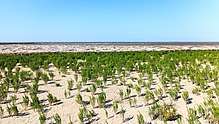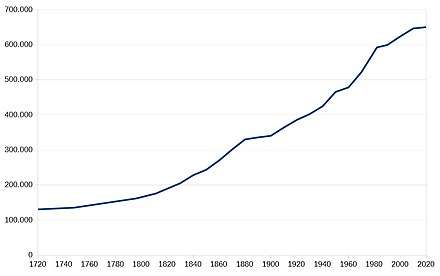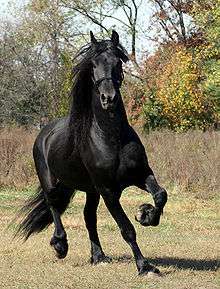Friesland
Friesland (/ˈfriːzlənd/ FREEZ-lənd, also US: /-lænd/ -land, Dutch: [ˈfrislɑnt] (![]()
![]()
Friesland Frisia | |
|---|---|
 Coat of arms | |
| Anthem: "De Alde Friezen" "The Old Frisians" | |
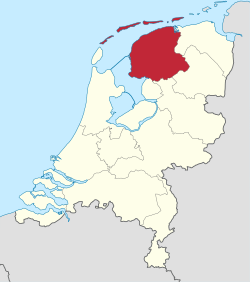 Location of Friesland in the Netherlands | |
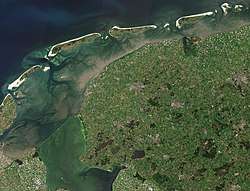 | |
| Coordinates: 53°8′N 5°49′E | |
| Country | |
| Capital (and largest city) | Leeuwarden (Ljouwert) |
| Government | |
| • King's Commissioner | Arno Brok (VVD) |
| Area (2017)[1] | |
| • Total | 5,749 km2 (2,220 sq mi) |
| • Land | 3,324 km2 (1,283 sq mi) |
| • Water | 2,425 km2 (936 sq mi) |
| Area rank | 1st |
| Population (1 January 2020)[2] | |
| • Total | 649,944 |
| • Rank | 8th |
| • Density | 196/km2 (510/sq mi) |
| • Density rank | 11th |
| Languages | |
| • Official | Dutch |
| • Recognised regional | West Frisian |
| Time zone | UTC+1 (CET) |
| • Summer (DST) | UTC+2 (CEST) |
| ISO 3166 code | NL-FR |
| Religion (2005) | Protestant 30% Roman Catholic 6% Muslim 2% |
| HDI (2017) | 0.904[3] very high · 10th |
| Website | www |
The capital and seat of the provincial government is the city of Leeuwarden (West Frisian: Ljouwert), a city with 123,107[5] inhabitants. Other large municipalities in Friesland are Sneek (pop. 33,512), Heerenveen (pop. 50,257) and Drachten (pop. 55,938). Since 2017, Arno Brok is the King's Commissioner in the province. A coalition of the Christian Democratic Appeal, the People's Party for Freedom and Democracy, the Labour Party and the Frisian National Party forms the executive branch. The province is divided into 18 municipalities. The area of the province was once part of the ancient, larger region of Frisia. The official languages of Friesland are West Frisian and Dutch.
Toponymy
In 1996 the States of Friesland resolved that the official name of the province should follow the West Frisian spelling rather than the Dutch spelling, resulting in "Friesland" being replaced by "Fryslân".[6] In 2004 the Dutch government confirmed this resolution, putting in place a three-year scheme to oversee the name change and associated cultural programme.[7]
The province of Friesland is occasionally referred to as "Frisia" by, amongst others, Hanno Brand, head of the history and literature department at the Fryske Akademy since 2009.[8] However, the English-language webpage of the Friesland Provincial Council refers to the province as "Fryslân".[9]
History
Prehistory
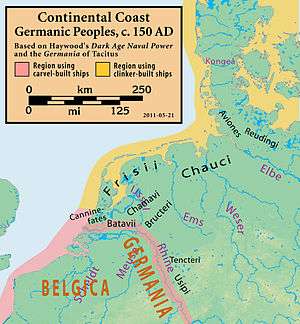
The Frisii were among the migrating Germanic tribes that, following the breakup of Celtic Europe in the 4th century BC, settled along the North Sea. They came to control the area from roughly present-day Bremen to Brugge, and conquered many of the smaller offshore islands. What little is known of the Frisii is provided by a few Roman accounts, most of them military. Pliny the Elder said their lands were forest-covered with tall trees growing up to the edge of the lakes.[10] They lived by agriculture[11] and raising cattle.[12]
In his Germania, Tacitus would describe all the Germanic peoples of the region as having elected kings with limited powers and influential military leaders who led by example rather than by authority. The people lived in spread-out settlements.[13] He specifically noted the weakness of Germanic political hierarchies in reference to the Frisii, when he mentioned the names of two kings of the 1st century Frisii and added that they were kings "as far as the Germans are under kings".[14]
In the 1st century BC, the Frisii halted a Roman advance and thus managed to maintain their independence.[15] Some or all of the Frisii may have joined into the Frankish and Saxon peoples in late Roman times, but they would retain a separate identity in Roman eyes until at least 296, when they were forcibly resettled as laeti[16] (Roman-era serfs) and thereafter disappear from recorded history. Their tentative existence in the 4th century is confirmed by archaeological discovery of a type of earthenware unique to 4th-century Frisia, called terp Tritzum, showing that an unknown number of Frisii were resettled in Flanders and Kent,[17] likely as laeti under the aforementioned Roman coercion. The lands of the Frisii were largely abandoned by c. 400 as a result of the conflicts of the Migration Period, climate deterioration, and the flooding caused by a rise in the sea level.
Early Middle Ages
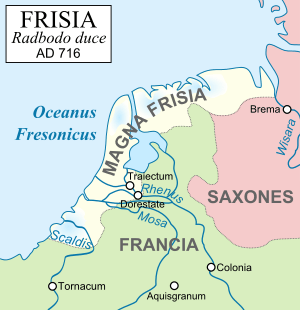
The area lay empty for one or two centuries, when changing environmental and political conditions made the region habitable again. At that time, during the Migration Period, "new" Frisians (probably descended from a merging of Angles, Saxons, Jutes and Frisii) repopulated the coastal regions.[18][19](p792) These Frisians consisted of tribes with loose bonds, centred on war bands but without great power. The earliest Frisian records name four social classes, the 'ethelings (nobiles in Latin documents; adel in Dutch and German) and frilings (vrijen in Dutch and Freien in German), who together made up the "Free Frisians" who might bring suit at court, and the laten or liten with the slaves, who were absorbed into the laten during the Early Middle Ages, as slavery was not so much formally abolished, as evaporated.[lower-alpha 1] The laten were tenants of lands they did not own and might be tied to it in the manner of serfs, but in later times might buy their freedom.[20](p202)
Under the rule of King Aldgisl, the Frisians came in conflict with the Frankish mayor of the palace Ebroin, over the old Roman border fortifications. Aldgisl could keep the Franks at a distance with his army. During the reign of Redbad, however, the tide turned in favour of the Franks; in 690, the Franks were victorious in the Battle of Dorestad.[21] In 733, Charles Martel sent an army against the Frisians. The Frisian army was pushed back to Eastergoa. The next year the Battle of the Boarn took place. Charles ferried an army across the Almere with a fleet that enabled him to sail up to De Boarn. The Frisians were defeated in the ensuing battle,[19](p795) and their last king Poppo was killed.[22] The victors began plundering and burning heathen sanctuaries. Charles Martel returned with much loot, and broke the power of the Frisian kings for good. The Franks annexed the Frisian lands between the Vlie and the Lauwers. They conquered the area east of the Lauwers in 785, when Charlemagne defeated Widukind. The Carolingians laid Frisia under the rule of grewan, a title that has been loosely related to count in its early sense of "governor" rather than "feudal overlord".[20](p205) About 100,000 Dutch drowned in a flood in 1228.[23]
Frisian freedom
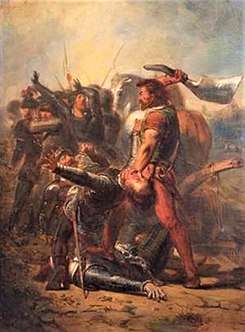
When, around 800, the Scandinavian Vikings first attacked Frisia, which was still under Carolingian rule, the Frisians were released from military service on foreign territory in order to be able to defend themselves against the heathen Vikings. With their victory in the Battle of Norditi in 884 they were able to drive the Vikings permanently out of East Frisia, although it remained under constant threat. Over the centuries, whilst feudal lords reigned in the rest of Europe, no aristocratic structures emerged in Frisia. This 'Frisian freedom' was represented abroad by redjeven who were elected from among the wealthier farmers or from elected representatives of the autonomous rural municipalities. Originally the redjeven were all judges, so-called Asega, who were appointed by the territorial lords.[24]
After significant territories were lost to Holland in the Friso-Hollandic Wars, Frisia saw an economic downturn in the mid-14th century. Accompanied by a decline in monasteries and other communal institutions, social discord led to the emergence of untitled nobles called haadlingen ("headmen"), wealthy landowners possessing large tracts of land and fortified homes[25] who took over the role of the judiciary as well offering protection to their local inhabitants. Internal struggles between regional leaders resulted in bloody conflicts and the alignment of regions along two opposing parties: the Fetkeapers and Skieringers. On 21 March 1498,[26] a small group of Skieringers from Westergo secretly met with Albert III, Duke of Saxony, the Governor of the Habsburg Netherlands, in Medemblik requesting his help.[27] Albrecht, who had gained a reputation as a formidable military commander, accepted and soon conquered all Friesland. Emperor Maximilian of Habsburg appointed Albrecht hereditary potestate and gubernator of Friesland in 1499.[28]
In 1515, an army of peasant rebels and mercenaries known as the Arumer Zwarte Hoop started a peasants' revolt against the Habsburg authorities.[29] The leader was the farmer Pier Gerlofs Donia, whose farm had been burned down and whose kinfolk had been killed by a marauding Landsknecht regiment. Since the regiment had been employed by the Habsburg authorities to suppress the civil war of the Fetkeapers and Skieringers, Donia put the blame on the authorities. After this he gathered angry peasants and some petty noblemen from Frisia and Gelderland and formed the Arumer Zwarte Hoop.The rebels received financial support from Charles II, Duke of Guelders, who claimed the Duchy of Guelders in opposition to the House of Habsburg. Charles also employed mercenaries under command of his military commander Maarten van Rossum in their support. However, when the tides turned against the rebels after the Donia's death in 1520, Charles withdrew his support, without which the rebels could no longer afford to pay their mercenary army.[30] The revolt was put to an end in 1523 and Frisia was incorporated into the Habsburg Netherlands, bringing an end to the Frisian freedom.[29]
Modern times

Charles V, the Holy Roman Emperor, became the first lord of the Lordship of Frisia. He appointed Georg Schenck van Toutenburg, who had crushed the peasants' revolt, as Stadtholder to rule over the province in his stead. When Charles abdicated in 1556, Frisia was inherited by Philip II of Spain along with the rest of the Netherlands. In 1566, Frisia joined the Dutch Revolt against Spanish rule.
In 1577, George de Lalaing, Count of Rennenberg was appointed Stadtholder of Frisia and other provinces. A moderate, trusted by both sides, he tried to reconcile the rebels with the Crown. But in 1580, Rennenburg declared for Spain. The States of Frisia raised troops and took his strongholds of Leeuwarden, Harlingen and Stavoren. Rennenburg was deposed and Frisia became the fifth Lordship to join the rebels' Union of Utrecht. From 1580 onward, all stadtholders were members of the House of Orange-Nassau. With the Peace of Münster in 1648, Frisia became a full member of the independent Dutch Republic, a federation of provincies. In economic and therefore also political importance, Friesland was next in rank to the provinces of Holland and Zeeland.
In 1798, three years after the Batavian Revolution, the provincial lordship of Frisia was abolished and its territory was divided between the Eems and Oude IJssel departments. This was short-lived, however, as Frisia was revived, however as a department in 1802. When the Netherlands were annexed by the First French Empire in 1810, the department was in French renamed Frise. After Napoleon was defeated in 1813 and a new constitution was introduced in 1814, Friesland became a province of the Sovereign Principality of the United Netherlands, then of the unitary Kingdom of the Netherlands a year later.
Geography
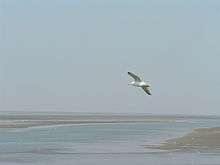
Friesland is situated at 53°8′N 5°49′E in the northwest of the Netherlands, west of the province of Groningen, northwest of Drenthe and Overijssel, north of Flevoland, northeast of the IJsselmeer and North Holland, and south of the North Sea. It is the largest province of the Netherlands if one includes areas of water; in terms of land area only, it is the third-largest province.
Most of Friesland is on the mainland, but it also includes a number of West Frisian Islands, including Vlieland, Terschelling, Ameland and Schiermonnikoog, which are connected to the mainland by ferry. The province's highest point is a dune at 45 metres (148 ft) above sea level, on the island of Vlieland.
There are four national parks of the Netherlands located in Friesland: Schiermonnikoog, De Alde Feanen, Lauwersmeer (partially in Groningen), and Drents-Friese Wold (also partially situated in Drenthe).
Urban areas
The ten urban areas in Friesland with the largest population are:[31]
| Dutch name | Frisian name | Population |
|---|---|---|
| Leeuwarden | Ljouwert | 92,235 |
| Drachten | Drachten | 45,080 |
| Sneek | Snits | 33,960 |
| Heerenveen | It Hearrenfean | 30,567 |
| Harlingen | Harns | 14,660 |
| Joure | De Jouwer | 13,070 |
| Wolvega | Wolvegea | 12,830 |
| Franeker | Frjentsjer | 12,810 |
| Dokkum | Dokkum | 12,575 |
| Lemmer | De Lemmer | 10,315 |
Municipalities

The province is divided into 18 municipalities, each with local government (municipal council, mayor and aldermen).
| Municipality | Population[32] | Total area[33] | Population density[32][33] | COROP | ||
|---|---|---|---|---|---|---|
| km2 | sq mi | /km2 | /sq mi | |||
| Achtkarspelen | 27,852 | 103.98 | 40.15 | 272 | 700 | North Friesland |
| Ameland | 3,673 | 268.50 | 103.67 | 62 | 160 | North Friesland |
| Dantumadiel | 18,923 | 87.53 | 33.80 | 222 | 570 | North Friesland |
| De Fryske Marren | 51,430 | 559.93 | 216.19 | 142 | 370 | South West Friesland |
| Harlingen | 15,758 | 387.67 | 149.68 | 630 | 1,600 | North Friesland |
| Heerenveen | 50,257 | 187.76 | 72.49 | 278 | 720 | South East Friesland |
| Leeuwarden | 123,107 | 255.62 | 98.70 | 516 | 1,340 | North Friesland |
| Noardeast-Fryslân | 45,181 | 516.45 | 199.40 | 120 | 310 | North Friesland |
| Ooststellingwerf | 25,497 | 226.11 | 87.30 | 114 | 300 | South East Friesland |
| Opsterland | 29,723 | 227.64 | 87.89 | 132 | 340 | South East Friesland |
| Schiermonnikoog | 936 | 199.07 | 76.86 | 21 | 54 | North Friesland |
| Smallingerland | 55,938 | 126.17 | 48.71 | 473 | 1,230 | South East Friesland |
| Súdwest-Fryslân | 89,710 | 841.56 | 324.93 | 195 | 510 | South West Friesland |
| Terschelling | 4,890 | 673.99 | 260.23 | 57 | 150 | North Friesland |
| Tytsjerksteradiel | 31,780 | 161.41 | 62.32 | 213 | 550 | North Friesland |
| Vlieland | 1,138 | 315.80 | 121.93 | 31 | 80 | North Friesland |
| Waadhoeke | 46,039 | 315.26 | 121.72 | 162 | 420 | North Friesland |
| Weststellingwerf | 25,840 | 228.45 | 88.21 | 117 | 300 | South East Friesland |
Climate
The province of Friesland has an oceanic climate (Köppen climate classification: Cfb).
| Climate data for Leeuwarden | |||||||||||||
|---|---|---|---|---|---|---|---|---|---|---|---|---|---|
| Month | Jan | Feb | Mar | Apr | May | Jun | Jul | Aug | Sep | Oct | Nov | Dec | Year |
| Record high °C (°F) | 12.6 (54.7) |
14.4 (57.9) |
20.4 (68.7) |
26.0 (78.8) |
28.7 (83.7) |
32.5 (90.5) |
31.4 (88.5) |
32.8 (91.0) |
29.1 (84.4) |
23.8 (74.8) |
16.4 (61.5) |
14.2 (57.6) |
32.8 (91.0) |
| Average high °C (°F) | 4.9 (40.8) |
5.4 (41.7) |
8.6 (47.5) |
12.4 (54.3) |
16.2 (61.2) |
18.5 (65.3) |
21.0 (69.8) |
21.1 (70.0) |
18.0 (64.4) |
13.7 (56.7) |
9.0 (48.2) |
5.6 (42.1) |
12.9 (55.2) |
| Daily mean °C (°F) | 2.7 (36.9) |
2.7 (36.9) |
5.3 (41.5) |
8.2 (46.8) |
12.0 (53.6) |
14.6 (58.3) |
17.0 (62.6) |
16.9 (62.4) |
14.2 (57.6) |
10.5 (50.9) |
6.5 (43.7) |
3.3 (37.9) |
9.5 (49.1) |
| Average low °C (°F) | 0.1 (32.2) |
−0.2 (31.6) |
1.9 (35.4) |
3.8 (38.8) |
7.4 (45.3) |
10.2 (50.4) |
12.6 (54.7) |
12.5 (54.5) |
10.2 (50.4) |
7.1 (44.8) |
3.6 (38.5) |
0.6 (33.1) |
5.8 (42.4) |
| Record low °C (°F) | −19.9 (−3.8) |
−16.3 (2.7) |
−16.3 (2.7) |
−5.9 (21.4) |
−1.7 (28.9) |
1.3 (34.3) |
5.7 (42.3) |
5.4 (41.7) |
2.0 (35.6) |
−6.0 (21.2) |
−14.2 (6.4) |
−19.2 (−2.6) |
−19.9 (−3.8) |
| Average precipitation mm (inches) | 68.9 (2.71) |
51.1 (2.01) |
58.1 (2.29) |
38.2 (1.50) |
57.3 (2.26) |
68.2 (2.69) |
74.5 (2.93) |
82.7 (3.26) |
84.3 (3.32) |
81.4 (3.20) |
82.1 (3.23) |
73.0 (2.87) |
819.8 (32.28) |
| Source: Royal Netherlands Meteorological Institute[34][35] | |||||||||||||
Demography
In 2020, Friesland had a population of 649,944 and a population density of 196/km2 (510/sq mi).
The years 1880–1900 show slower population growth due to a farm crisis during which some 20,000 Frisians emigrated to the United States.[36]
|
|
|
|---|
Anthropometry
Since the late Middle Ages, Friesland has been renowned for the exceptional height of its inhabitants, who were deemed among the tallest groups of Indo-Europeans. Even early Renaissance poet Dante Alighieri refers to the height of Frisians in his Divine Comedy when, in the canticle about Hell, he talks about the magnitude of an infernal demon by stating that "not even three tall Frieslanders, were they set one upon the other, would have matched his height".[39]
Economy
Friesland is mainly an agricultural province. The black and white Frisian cattle, black and white Stabyhoun and the black Frisian horse originated here. Tourism is another important source of income: the principal tourist destinations include the lakes in the southwest of the province and the islands in the Wadden Sea to the north. There are 195 windmills in the province of Friesland, out of a total of about 1200 in the entire country.
The Gross domestic product (GDP) of the region was 19.8 billion € in 2018, accounting for 2.6% of the Netherlands economic output. GDP per capita adjusted for purchasing power was 26,700 € or 89% of the EU27 average in the same year.[40]
Culture
Languages
Friesland is the only one of the twelve provinces of the Netherlands to have its own language that is recognized as such, West Frisian. Before the 18th century, varieties of Frisian were also spoken in the provinces of North-Holland and Groningen, and together with the Frisian speakers in Ost-Friesland and North-Friesland a continuous linguistic area existed between Amsterdam and the present day Danish-German border.
According to a study carried out in 2007, West Frisian is the native language of the 54.3% of the inhabitants of the province of Friesland, followed by Dutch with 34.7%, and speakers of other regional languages, most of these restricted to Friesland, with 9.7%, and in the end other foreign languages with 1.4%. Frisian speakers are traditionally underrepresented in urban areas, and predominant in the countryside.[41]
West-Frisian is also spoken in a small adjacent part of the province of Groningen. Up to the 18th century Frisian was spoken in the, at that time Prussian and Hannoveran, lordships of Ost-Friesland (East-Friesland). Since then the Ost-Frisian population switched to East Frisian (Ostfriesisch), a Low German dialect. Only in some, formerly remoted, East-Frisian villages (Saterland) a variety of historically East Frisian (Seeltersk) is still in use but by an older generation. A collection of dialects named North Frisian, is or was spoken in North Friesland, alongside the North See Coast and on the islands of Slesvig-Holstein. The named Frisian languages are historically related to Old English which points at the fact that Anglians and Saxons, eventually accompanied by Frisians, came from these areas.
In Stellingwerf, in south-east Friesland, a dialect of Low Saxon is spoken.[42]
The language policy in Friesland is preservation. West Frisian is a mandatory subject in Friesland in primary and secondary schools of the Frisian speaking districts. The bilingual (Dutch-Frisian) and trilingual (Dutch-English-Frisian) schools in the province of Friesland use in some lessons West-Frisian as a language of instruction, besides Dutch in most other lessons and next to them English. Literacy in Frisian however, is not often a core aim and that makes the number of Frisians speakers able to write in Frisian only 12%.[43] The provincial government takes various initiatives to preserve the West Frisian language. All parents in Friesland receive, at their children's birth, information about language and multilingualism (ex. 'taaltaske'). To support the use of Frisian in public and at public events, the province also invests in the development of speech pathology materials and strives to create information technology devices for the West Frisian language. The Frisian government subsidizes the Afûk organization, which offers language courses and actively promotes Frisian in all sectors of society as well as the corporate domain which as a rule is dominated by Dutch and Modern English.[44] The province also promotes a wide range of art and entertainment in Frisian.[45]
Sports
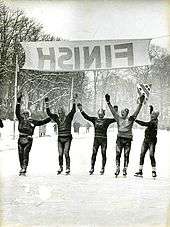
The province is famous for its speed skaters, with mass participation in cross-country ice skating when weather conditions permit. When winters are cold enough to allow the freshwater canals to freeze hard, the province holds its traditional Elfstedentocht (Eleven cities tour), a 200-kilometre (120 mi) ice skating tour. A traditional sport is Frisian handball. Another Frisian practice is fierljeppen, a sport with some similarities to pole vaulting. A jump consists of an intense sprint to the pole (polsstok), jumping and grabbing it, then climbing to the top while trying to control the pole's forward and lateral movements over a body of water and finishing with a graceful landing on a sand bed opposite to the starting point. Because of all the diverse skills required in fierljeppen, fierljeppers are considered to be very complete athletes with superbly developed strength and coordination. In the warmer months, many Frisians practice wadlopen, the traditional art of wading across designated sections of the Wadden Sea at low tide.
There are currently two top level football clubs playing in Friesland: SC Cambuur from Leeuwarden (home stadium Cambuur Stadion) and SC Heerenveen (home stadium Abe Lenstra Stadion).
Politics
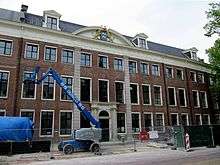
The King's Commissioner of Friesland is Arno Brok.[46] The States of Friesland have 43 seats. The Provincial Executive is a coalition of the Christian Democratic Appeal, the People's Party for Freedom and Democracy, the Labour Party and the Frisian National Party (FNP).
| Party | Votes | Seats | |
|---|---|---|---|
| Christian Democratic Appeal | 49.704 | 8 | |
| Forum for Democracy | 40.055 | 6 | |
| Labour Party | 39.976 | 6 | |
| People's Party for Freedom and Democracy | 28.073 | 4 | |
| Frisian National Party | 23.662 | 4 | |
| GreenLeft | 22.935 | 3 | |
| ChristianUnion | 19.673 | 3 | |
| Party for Freedom | 17.287 | 3 | |
| Socialist Party | 15.426 | 2 | |
| Democrats 66 | 12.284 | 2 | |
| Party for the Animals | 9.618 | 1 | |
| 50PLUS | 7.595 | 1 | |
| Total | 298.241 | 43 | |
Transport
The four motorways in the province are A6, A7 (E22), A31, and A32.[49]
The main railway station of Friesland is Leeuwarden, which connects the railways Arnhem–Leeuwarden, Harlingen–Nieuweschans, and Leeuwarden–Stavoren which are all (partially) located in the province.
| Trajectory | Railway stations in Friesland |
|---|---|
| Arnhem–Leeuwarden | Drenthe – Wolvega – Heerenveen IJsstadion – Heerenveen – Akkrum – Grou-Jirnsum – Leeuwarden |
| Harlingen–Nieuweschans | Harlingen Haven – Harlingen – Franeker – Dronryp – Deinum – Leeuwarden – Leeuwarden Camminghaburen – Hurdegaryp – Feanwâlden – De Westereen – Buitenpost – Groningen |
| Leeuwarden–Stavoren | Leeuwarden – Mantgum – Sneek Noord – Sneek – IJlst – Workum – Hindeloopen – Koudum-Molkwerum – Stavoren |
Ameland Airport near Ballum[50] and Drachten Airfield near Drachten[51] are the two general aviation airports in the province. The Royal Netherlands Air Force uses Vlieland Heliport and the Leeuwarden Air Base.
Literature
- Helma Erkelens, Taal fen it hert. Language of the Heart. About Frisian Language and Culture, Province of Fryslân, Leeuwarden 2004
- John Hines & Nelleke IJssennagger (eds.), Frisians and their North Sea Neighbours: From the Fifth Century to the Viking Age, Boydell & Brewer, Woodbridge/Rochester 2017
- Goffe Jensma, 'Minorities and Kinships. The Case of Ethnolinguistic Nationalism in Friesland’, in: P. Broomans et al. (eds.), The Beloved Mothertongue. Ethnolinguistic Nationalism in Small Nations: Inventories and Reflections, Peeters, Louvain-Paris-Dudley 2008, p. 63-78
- Horst Haider Munske (ed.), Handbuch des Friesischen / Handbook of Frisian Studies, Max Niemeyer, Tübingen 2001
- Oebele Vries, 'Frisonica libertas: Frisian Freedom as an Instance of Medieval Liberty', in: Journal of Medieval History 41 (2015), nr. 2, p. 229-248
Media
Friesch Dagblad[52] and Leeuwarder Courant[53] are daily newspapers mainly written in Dutch. Omrop Fryslân is the public broadcaster with radio and TV programs mainly in Frisian.[54]
Notes
- Homans describes Frisian social institutions, based on the summary by Siebs, Benno E. (1933). Grundlagen und Aufbau der altfriesischen Verfassung. Untersuchungen zur deutschen staats- und Rechtsgeschichte (in German). 144. Breslau: Marcus. OCLC 604057407. Siebs' synthesis was extrapolated from survivals detected in later medieval documents.[20]
References
- http://www.waarstaatjeprovincie.nl/Paginas/Ruimtelijke%20ordening/Oppervlakte.aspx
- https://opendata.cbs.nl/statline/#/CBS/nl/dataset/37230ned/table
- "Sub-national HDI - Area Database - Global Data Lab". hdi.globaldatalab.org. Retrieved 2018-09-13.
- https://opendata.cbs.nl/statline/#/CBS/nl/dataset/37230ned/table?ts=1581415402485
- https://opendata.cbs.nl/statline/#/CBS/nl/dataset/70072ned/table
- "Beslut fan Provinsjale Staeten van Friesland" [Resolution of the Provincial Council of Friesland]. Provinciaal Blad van Friesland (in Western Frisian) (7). 28 March 1996.
- "Ook voor rijk heet Friesland Fryslân" [Friesland to be called Fryslân across the realm]. Leeuwarder Courant (in Dutch). 10 November 2004. Retrieved 11 August 2012.
- Brand, A. J. (2011). "Frisians". In Cole, J. E. (ed.). Ethnic Groups of Europe: An Encyclopedia. Santa Barbara, California: ABC-Clio. p. 150. ISBN 978-1-59884-302-6.
- "provinsje Fryslan, provincie fryslan English". provinsje Fryslan/provincie fryslan. Retrieved 11 August 2012.
- Pliny the Elder & 79_3:340–341, Natural History, Bk XVI Ch 2: Wonders connected with trees in the northern regions.
- Tacitus 117:253, The Annals, Bk XIII, Ch 54. Events of AD 54–58. This was confirmed by Tacitus when he said that in an incident where the Frisii had taken over land, they then settled into houses, sowed the fields, and cultivated the soil.
- Tacitus 117:147–148, The Annals, Bk IV, Ch 72–74. Events of AD 15–16. Tacitus specifically refers to the herds of the Frisii.
- Tacitus & 98:18–19, 23–24, 36–37, The Germany, Ch V, VII, XVI.
- Tacitus 117:253, The Annals, Bk XIII, Ch 54. Events of AD 54–58.
- Minahan, James (2000). One Europe, many nations : a historical dictionary of European national groups. Westport, Conn: Greenwood Press. p. 264. ISBN 9780313309847.
- Grane, Thomas (2007), "From Gallienuso Probus - Three decades of turmoil and recovery", The Roman Empire and Southern Scandinavia–a Northern Connection! (PhD thesis), Copenhagen: University of Copenhagen, p. 109
- Looijenga, Jantina Helena (1997), "History, Archaeology and Runes", in SSG Uitgeverij (ed.), Runes Around the North Sea and on the Continent AD 150–700; Texts and Contexts (PhD dissertation) (PDF), Groningen: Groningen University, p. 40, ISBN 90-6781-014-2. Looijenga cites Gerrets' The Anglo-Frisian Relationship Seen from an Archaeological Point of View (1995) for this contention.
- Bazelmans 2009:321–337, The case of the Frisians.
- Halbertsma, Herrius (1982). "Summary" (PDF). Frieslands Oudheid (Thesis) (in Dutch and English). Groningen: Rijksuniversiteit Groningen. pp. 791–798. OCLC 746889526.
- Homans, George C. (1957). "The Frisians in East Anglia". The Economic History Review. New series. Wiley. 10 (2): 189–206. doi:10.2307/2590857. ISSN 0013-0117. JSTOR 2590857.
- Blok, Dirk P. (1968). De Franken : hun optreden in het licht der historie. Fibulareeks (in Dutch). 22. Bussum: Fibula-Van Dishoeck. pp. 32–34. OCLC 622919217. Retrieved 2014-09-17.
- "Geschiedenis van het volk der Friezen". boudicca.de (in Dutch). 2003. Archived from the original on 2009-06-08. Retrieved 2009-01-22.
- Holloway, Diane; Cheney, Bob; Spreen, Johannes (2005). Who Killed New Orleans?: Mother Nature Vs. Human Nature. p. 29. ISBN 9780595373918.
- Heinrich Schmidt: Politische Geschichte Ostfrieslands. 1975, p. 22 ff.
- Medieval Germany: An Encyclopedia, John M. Deep, Pub. 2001, Germany.
- Markus Meumann, Jörg Rogge (Hg.). Die besetzte "res publica". Zum Verhältnis von ziviler Obrigkeit und militärischer Herrschaft in besetzten Gebieten vom Spätmittelalter bis zum 18. Jahrhundert, Pg. 137. Papers from a conference held Sept. 20-21, 2001, at the Martin-Luther-Universität Halle-Wittenberg. By Markus Meumann, Jörg Rogge. Published 2006 LIT Verlag Berlin -Hamburg-Münster.
- The New Encyclopædia Britannica, Published by Encyclopædia Britannica Inc., 1993, p. 214.
- The Dutch Republic in the Seventeenth Century: The Golden Age by Maarten Prak, Pub 2005
- "Greate Pier fan Wûnseradiel" (in Western Frisian). Gemeente Wûnseradiel. Archived from the original on 2012-09-07. Retrieved 2008-01-04.
- Kalma, J.J. (1970). de Tille (ed.). Grote Pier Van Kimswerd. Netherlands. p. 50. ISBN 90-70010-13-5.
- CBS Statline 2018.
- "Bevolkingsontwikkeling; regio per maand" [Population growth; regions per month]. CBS Statline (in Dutch). CBS. 1 January 2019. Retrieved 1 January 2019.
- "Kerncijfers wijken en buurten" [Key figures for neighbourhoods]. CBS Statline (in Dutch). CBS. 2 July 2013. Retrieved 12 March 2014.
- (in Dutch) Leeuwarden extremen tijdvak 1971 t/m 2000, Royal Netherlands Meteorological Institute. Retrieved on 26 April 2014.
- (in Dutch) Leeuwarden, langjarige gemiddelden, tijdvak 1981–2010, Royal Netherlands Meteorological Institute. Retrieved on 26 April 2014.
- (in Dutch) Emigration to the United States.
- (in Dutch) Overzicht aantal inwoners Provincie Friesland 1714–2000, Tresoar.
- (in Dutch) Bevolking; geslacht, leeftijd, burgerlijke staat en regio, 1 januari, Statistics Netherlands, 2014.
- Alighieri, Dante. Divine Comedy, "Inferno", Canto 31, line 64, in The Portable Dante, ed. Paolo Milano, trans. Laurence Binyon, Penguin, 1975 ISBN 0-14-015032-3
- "Regional GDP per capita ranged from 30% to 263% of the EU average in 2018". Eurostat.
- "Rapportage quick scan Friese taal 2007 Provincie Fryslân - PDF". docplayer.nl. Retrieved 2018-06-10.
- Hammarström, Harald; Forkel, Robert; Haspelmath, Martin, eds. (2017). "Stellingwerfs". Glottolog 3.0. Jena, Germany: Max Planck Institute for the Science of Human History.
- (Hilton, 2013)
- (Afûk 2011)
- Hilton, N. H., & Gooskens, C. (2013). Language policies and attitudes towards Frisian in the Netherlands. Phonetics in Europe: Perceptions and production, 139-157.
- "De heer Arno Brok" (in Dutch), Province of Friesland. Retrieved 7 March 2017.
- (in Dutch) Provinciale Staten 20 maart Fryslân, Retrieved on 9 Augustus 2019.
- (in Dutch) Station Leeuwarden in Leeuwarden, Rijksmonumenten.nl. Retrieved on 26 April 2014.
- (in Dutch) Wegenoverzicht, Rijkswaterstaat. Retrieved on 27 April 2014.
- (in Dutch) Algemene informatie, Ameland Airport. Retrieved on 27 April 2014.
- (in Dutch) Aanwijzingsbesluit Luchthaven Drachten Archived 2014-04-28 at the Wayback Machine, 2007. Retrieved on 27 April 2014.
- (in Dutch) Missie Friesch Dagblad, Friesch Dagblad. Retrieved on 27 April 2014.
- (in Dutch) Over de LC Archived 2013-09-17 at the Wayback Machine, Leeuwarder Courant. Retrieved on 27 April 2014.
- (in West Frisian) Oer de Omrop, Omrop Fryslân. Retrieved on 27 April 2014.
External links
| Wikimedia Commons has media related to Friesland. |
| Wikivoyage has a travel guide for Friesland. |
- Province of Fryslân, official government website
- Provincial Tourist Board
- Frisian Film Archive
- . Encyclopædia Britannica (11th ed.). 1911.

_en_omgeving_04.jpg)
